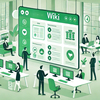
The world will be celebrating International Literacy Day on September 8. Launched by UNESCO in 1966, it is still an important day for the whole international society.
Modern technology advancements make us think we are living in the world of the future now. With buzzwords like neural networks and virtual assistants, it is so for at least some of us. But while we are puzzling our heads over whether deep fakes are going to cause the next international conflict, every 5th person on planet Earth is illiterate.
And, two-thirds of them are women. Our world is weird indeed just as it is full of extremes and double-standards.
You didn’t come here to be called a hypocrite, of course, but we are all being hypocritical here at times. For example, technical writers are paying a lot of attention to target audiences, and we talked about that a lot in this techcomm blog. We all seem to be concerned about making technical documentation more readable, but what we’ve been missing out on is a simple “what if”. What if your product falls into the hands of someone who is struggling to read?
Technical Writing and Illiteracy
Understandably, a lot of technical documents are simply not meant for people unable to read. Fields like aerospace, IT, the GHG sector, engineering and science clearly require a person to be literate. With the exception of some rare scenarios, there will hardly ever be a need for a person struggling to read to open a spaceship user manual or a scientific white paper.
With that excluded, we are left with companies that produce some more general and down-to-earth stuff. And, that’s where the difficulties begin.
Aside from explaining how things work, technical documentation is supposed to eliminate possible dangers of product usage. If we think about it, that’s, actually, the primary goal of it. The fact that something doesn’t work is sad, but if people’s lives and health are in danger that is unacceptable, not sad.
To Whom it May Concern
When you work in the office and live in a nice neighborhood, it is easy to overlook the scale of low literacy. About 40% of Americans have low literacy. Imagine what the numbers could show for countries with lower living standards and weaker economies.
Availability of documentation connected with certain areas is a point of major concern for everybody. These areas include healthcare, government, law, retail and more. To function successfully in the modern society, people with low literacy need to understand at least technical documents connected with the above-mentioned things. This defines their well-being in many ways, and technical writers can contribute a lot to this matter.

What You Can Do
Struggling readers have come up with their own ways of consuming and digesting information. They had to – they need to survive somehow. But technical writers can actually do something to make their lives easier. Here are several ideas of adapting content to low-literate people’s needs:
Use lists
Struggling readers find it difficult to single out what’s important when there’s a wall of text. No wonder. This is a skill that needs to be trained. Lists can help the situation.
Be careful with terms, jargon and abbreviations
Clearly, terms are unavoidable, but it is how you handle them what matters most. Every term needs to be explained while some don’t even have to be used in a user manual if they are too techy. Jargon is trickier, try being super critical about it. The trickiness lies in the fact that the words you are using on a daily basis can be unknown for your readers.
Watch out for complex sentences
Reading long sentences feels uncomfortable even for a prepared reader. A common guideline for English states we should have 15-20 words in a sentence. But studies show that the shorter a sentence is, the better it is understood. Try not to go beyond 20 words per sentence. Keep it concise and clear.
Use images
Images are great for showcasing even the most difficult concepts. Screenshots, schemes and graphs can speak words when text is too abstract. Besides that, remember pictorial choking hazard warnings? That’s how images can literally save lives and ensure safety.
Take advantage of headings and indention
Using headings and indention to their full extent creates better text structure. Texts automatically become more readable, and easier to navigate through.
Single out important words
There’s nothing weird about writing the most important words in bold. That’s where all the attention of your reader will go. Of course, warnings deserve special treatment in this context. It is better to accompany a warning text with an exclamation sign icon or even some graphics like in the choking hazard example.
Conclusion
International Literacy Day is a great possibility of bringing positive changes for millions of people. The issue of illiteracy deserves more attention for sure. And, engagement of technical writers into this movement can do a lot of good!
Good luck with your technical writing!
ClickHelp Team
Author, host and deliver documentation across platforms and devices




